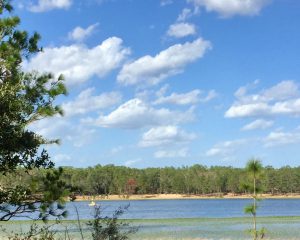Do you like field trips? Do you love getting out and having an adventure? If so I would love to tell you about our 2017 Master Gardener field trip to the Ordway-Swisher Biological Station. I’m going to start out by telling you how beautiful and full of nature this amazing place is with 9,500 plus acres you will never have a dull moment. This trip would have not been the same without our wonderful Master Gardeners who absolutely made the trip a great success and even better company to share this experience. Everyone started the day by meeting at the office around 10:30 am once everyone arrived we set out on our adventure picking up a great lunch and taking it to the Ordway-Swisher site where they have a wonder office/conference room area to have lunches and gatherings.They set our group of 14 up on a trolley ride where Andrew Rappe the Assistant Director gave us a educational tour he has so much knowledge and understanding there was not a question he did not know . The tour lasted a good hour and a half we made many stops along the way where Andrew gave us some in site and history on the Ordway-Swisher site.

HISTORY
The Ordway-Swisher Biological Station is a University of Florida research support facility established for the long-term study and conservation of unique ecosystems through management, research, and education. OSBS currently comprises over 9,500+ acres with building facilities to support research, education, and conservation efforts. Field stations serve a number of critical scientific functions. They give researchers reliable access to the environment. Accumulate and integrate multidisciplinary, place-based knowledge that provides a baseline from which to evaluate environmental change and predict how biological systems may respond to it in the future. They also transform the lives of students of all ages and serve as training grounds for the next generation of scientific leaders. Finally, they are on the front lines of integrating science into decision-making and of communicating science to the general public

Carl S. Swisher began purchasing land in the late 1920s through his death in the early 1970s and for 50 years used the tract as their private hunting and fishing preserve. At his death he had amassed almost 25,000 acres. In 1979 the Swisher Foundation approached The Nature Conservancy for assistance in establishing a wildlife sanctuary as a monument to the late tobacco industrialist, Carl Swisher. Two tracts of land, totaling 3000 acres of wetlands and prairies, were donated to The Nature Conservancy. The acreage was named the Carl Swisher Memorial Sanctuary.

In early 1980, the Goodhill Foundation awarded a grant to the University of Florida Foundation, Inc., to purchase approximately 6,000 acres of upland high pine sandhills from the Swisher Foundation. This acreage was to be preserved in the name of Katharine Ordway, the 3M Corporation heiresses who founded Goodhill. A conservation easement was placed across the Ordway tract to secure its protection in perpetuity. Both tracts were contiguous and so The Nature Conservancy agreed to lease the Carl Swisher Memorial Sanctuary to the University of Florida Foundation, Inc., and both organizations signed a joint stewardship agreement for the combined properties. The facility was to be operated as a field station to further the study and conservation of unique ecosystems.
In 2006, The Nature Conservancy transferred their ownership of the Sanctuary to UF. In order to more clearly identify the facility’s use and purpose, the University of Florida Board of Trustees renamed the facility as the Ordway-Swisher Biological Station that same year. Additional lands have been added over the years to OSBS for the purpose of maximizing conservation protection and increasing research and education opportunities.
to learn more please visit: http://ordway-swisher.ufl.edu/Index.aspx





.
 0
0
